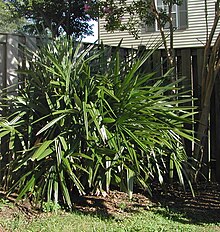Rhapidophyllum hystrix
| Rhapidophyllum hystrix subsp. var. | Needle Palm | |||||||||||||||||||||||||||||||||||||||||||||||||||||||
|---|---|---|---|---|---|---|---|---|---|---|---|---|---|---|---|---|---|---|---|---|---|---|---|---|---|---|---|---|---|---|---|---|---|---|---|---|---|---|---|---|---|---|---|---|---|---|---|---|---|---|---|---|---|---|---|---|

|
|
| ||||||||||||||||||||||||||||||||||||||||||||||||||||||
| ||||||||||||||||||||||||||||||||||||||||||||||||||||||||
Rhapidophyllum hystrix (Needle Palm) is a palm, the sole member of the genus Rhapidophyllum. It is native to the southeastern United States, from central Florida to Georgia, Mississippi, South Carolina and Alabama. It is one of the most cold-hardy palms in the world.
The Needle Palm assumes a shrublike clumping form with several stems growing from a single base, the stems growing very slowly and tightly together, eventually forming a dense base 1 - 1.2 m tall, with numerous sharp needle-like spines produced between the leaves; these are 10 - 25 cm long and protect the stem growing point from browsing animals. The whole plant can reach 2 - 3 m tall to the top of the erect central leaves. It is a fan palm (Arecaceae tribe Corypheae), with the leaves with a long petiole terminating in a rounded fan of 8–16 leaflets; each leaf is up to 2 m ft long, with the leaflets up to 60 - 80 cm long. The flowers are borne in dense, short clusters at the top of the stems; it is usually dioecious with male and female flowers on separate plants. The fruit is a brown drupe about 2 cm in long.
The scientific name Rhapidophyllum means "needle-leaf", while hystrix is from the scientific name of a genus of porcupines. The English name likewise refers to the needle-like spines produced at the petiole bases; for similar reasons, it is also occasionally called "porcupine palm".
The Needle Palm is very popular among palm enthusiasts in temperate climates for its extraordinary ability to tolerate cold. Some reports have claimed survival of temperatures as low as −29°C, although more realistic estimates are approximately −15° to −21°C. A large, well-established specimen has been growing without protection at the United States National Arboretum in Washington, D. C. since the 1960s, a specimen at the Brooklyn Botanic Gardens has been flourishing for years, and there are several specimens thriving in the Greater Cincinnati area where extensive published research has been led by Miami University, Ohio. However, unlike the related Trachycarpus species, Needle Palms need hot, humid summer temperatures to thrive and the species does not grow well in the Pacific Northwest. It is, however, becoming one of the most popular palms for planting in the Chesapeake Bay area of Maryland and Virginia, as well as the Outer Banks of North Carolina.
It grows far north as coastal parts of the New York area without protection, specifically Connecticut (see range map), and somewhat farther north (New England) with protection.
The Needle Palm is considered to be commercially exploited and therefore threatened. When purchasing this palm, it is wise to purchase it only from a reputable dealer, as some unscrupulous dealers harvest them directly from the wild.
| Standard Cyclopedia of Horticulture |
|---|
|
Rhapidophyllum hystrix, H. Wendl. & Drude (Chamaerops hystrix, Fraser). St. 2-3 ft., erect or creeping, proliferous, clothed with the fibrous remains of lf.-sheaths intermingled with long, erect spines: lvs. 3—4 ft., somewhat glaucous especially beneath, circular in outline, with numerous 2-4- toothed segms.; petiole triangular, rough on the margins: sheaths of oblique fibers interwoven with numerous strong, erect spines: spadix 6-12 in. long, short- peduncled: petals ovate, drupe 3/4-l in. long. S. C. to Fla.
|
Describe the plant here...
Cultivation
Propagation
Pests and diseases
Species
Gallery
If you have a photo of this plant, please upload it! Plus, there may be other photos available for you to add.
References
- Standard Cyclopedia of Horticulture, by L. H. Bailey, MacMillan Co., 1963
External links
- w:Rhapidophyllum hystrix. Some of the material on this page may be from Wikipedia, under the Creative Commons license.
- Rhapidophyllum hystrix QR Code (Size 50, 100, 200, 500)

